D-4 rocket complex with a P-21 ballistic missile
The development of the first Russian ballistic missile for submarines with submarines began in 1958 in the Dnepropetrovsk OKB-586 (now Yuzhnoye Design Bureau). From the designers headed by M.K. Yangel was required to create a missile system that does not require an ascent from the submarine before firing. The project also involved developers of submarines and additional missile systems. Together, they had to create a complete set of necessary equipment, as well as submarines-carriers of missile weapons.
The project of a new missile system for submarines received the designation D-4. The missile was to be designated as P-21. In addition, the rocket was assigned the index GRAU 4K55.
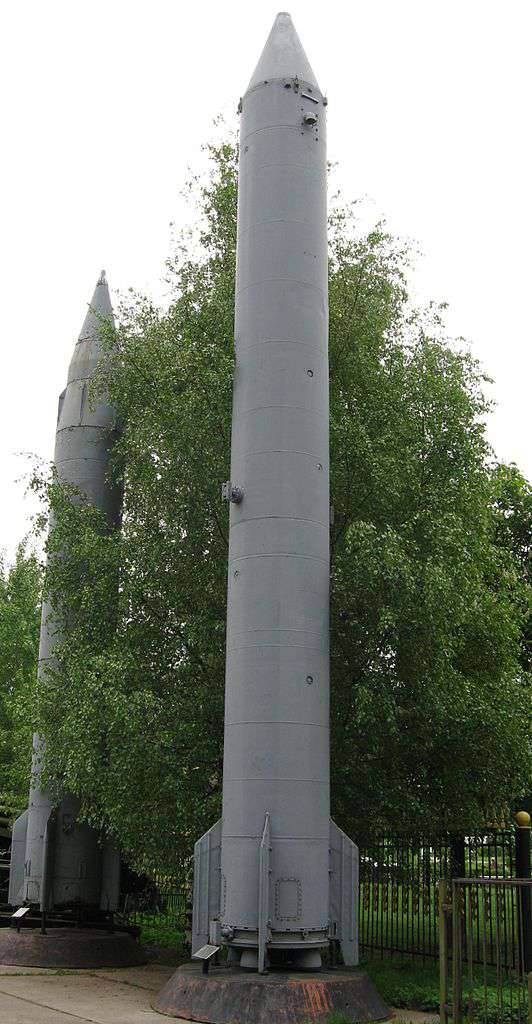
Rocket R-21 in the museum. Photo of Wikimedia Commons
In May 1959, a resolution of the Council of Ministers was issued, according to which the development of the D-4 / R-21 project was transferred from OKB-586 to SKB-385, headed by V.P. Makeev. Also at this time it was decided that now all ballistic missiles for fleet SKB-385 will be created. OKB-586 and its team, in turn, should now deal only with missiles for land complexes. In particular, the resolution of the Council of Ministers boosted work on the projects of the R-14 and R-16 missiles.
The basis for the P-21 rocket should have been the groundwork for previous pilot projects. So, in February, 1955, the OKB-1 was instructed to study the underwater launch of the missiles and create a version of the R-11FM rocket adapted for such a launch. Over the next few years, several experimental products were developed and a series of studies were carried out with the launch of special mock-ups and experienced rockets. Such studies have allowed us to collect all the necessary data that was later used in the development of new weapons for submarines.
The first studies were conducted using a special C4.1 layout and a submersible stand. The basis of the layout of the first model was the body of the R-11FM rocket, from which the liquid engine and all control systems were dismantled. To maintain proper balancing, the tanks were filled with water, and in the tail section of the hull three solid-fuel engines with traction cutters were attached. Also on board the layout there were various measuring equipment. The test bench was a pontoon with a launch shaft 12 m in height with a diameter of 2 m. With the help of a cable, a block and a winch, the pontoon with a rocket could sink to depth and thereby simulate the launch of a submarine missile.
25 December 1956, the first test launch of the С4.1 mockup took place from the submerged stand at the test site near the city of Balaclava. The solid propellant engines removed the mock-up from under the water and raised it to a height of 150 m, after which the shut-off devices worked, and the product fell into the water. Several such launches allowed to study the loads acting on the missile during an underwater launch, as well as to determine the need for certain modifications. After testing with the use of a stationary stand-pontoon, the project moved to the stage of inspections using a submarine carrier.
In the first half of 1957, the C-229 submarine of the 613 project was upgraded. The revision of the B-613 project implied the installation of a set of special equipment, as well as the installation of two vertical launchers along the sides of the robust hull. Such improvements have led to a characteristic change in the appearance of the submarine. Subsequently, this boat was once again refined to participate in new tests and was also distinguished by the presence of unusual elements.
On July 9, the C-229 submarine produced the first launch of the C4.1 mock-up from a submerged position. Being at a depth of 29 m and moving at a speed of 2,5 node, the submarine successfully launched a ballistic missile model. Until the end of July, two more shots were carried out, in which the submarine reached speeds up to the 4,5 node, and the sea was reaching 2-3 points. All three launches were considered successful. The tests were not continued due to the exhaustion of the existing stock of C4.1 products.
On the basis of existing solutions and new proposals, using the experience of testing the C4.1 product, a new layout was developed for conducting inspections - the C4.5. It was a modified version of the R-11FM rocket with a fluid engine and a simplified set of onboard equipment. Like the previous product, С4.5 was planned to be used only in tests to gather information necessary for the development of high-grade missile weapons.
29 March 1958, the C-229 submarine entered the landfill with the C4.5 on board. From the depth of 30 m at a speed of 3,5 node and the excitement 2 points the submarine successfully launched the layout. The product came out of the water, rose to a height of 60 m, but when it fell, it broke against the water. Before 11 April, inclusive, they performed two more launches with the same parameters. The second model С4.5 was not destroyed and was sent for research. The third, in turn, crashed in the fall. Three launches of C4.5 mockups with liquid engines made it possible to work out some of the new ideas and allow us to continue creating a full-fledged submarine launch vehicle.
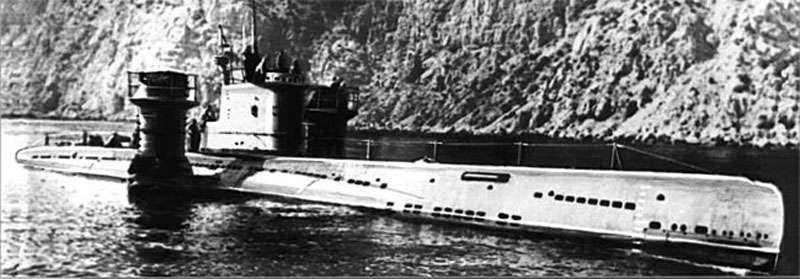
Submarine C-229 after revision with the installation of two airborne launchers. Photo Deepstorm.ru
The next stage of the project began with the resolution of the Council of Ministers on January 23 of 1958 of the year. This document prescribed to re-equip the existing submarine B-67 of the project PV-611 to carry a new experimental ballistic missile. In accordance with the decree, a new version of the experimental rocket under the designation C4.7 was also developed. From the point of view of design, it was a P-11FM rocket with some modifications made in the light of previous tests.
Tests of the B-67 submarine with the C4.7 product began in August 1959 at the White Sea test site. The first launch attempt failed. The submarine's automatics signaled a successful launch of the rocket, but observers on the surface vessel, who monitored the tests, did not see the start. After the ascent of the submarine and the opening of the silo launcher, a spontaneous launch of the rocket occurred. After this failure, an investigation into the causes of the accident began, followed by the correction of the identified deficiencies.
The second launch, held in August 1960, also ended in an accident. When the mine was filled with water before launching, the seawater feed system malfunctioned, which caused the rocket to be pushed off the launch pad. In addition, it tore off and threw overboard the head part. It took new improvements, but this time the tests were continued only a month later.
The third launch of the С4.7 product from the B-67 submarine took place on 10 in September of the same year and passed without any technical problems. With certain reservations regarding the design of the used layout, these tests can be considered the first in the domestic practice of launching a ballistic missile from a submerged submarine.

Scheme submarine C-229 after upgrading with the installation of one launcher CM-87. Photo Deepstorm.ru
Simultaneously with the testing of later mock-ups, a full-fledged rocket was being designed, which was to become the armament of submarines. Within the framework of the P-21 project, it was proposed to carry out several stages of testing with the use of both high-grade products and models with similar characteristics. For launches during the tests it was planned to use fixed stands with the possibility of submersion, as well as submarines with launchers and other equipment.
The first launches of the P-21 project were carried out using the K1.1 layout. In fact, it was a full-fledged prototype of a combat missile, which differed from it in some design features. First of all, the volume of fuel tanks was reduced to reduce the range to acceptable values during testing. The power plant and part of the control equipment was borrowed from the original project. In the future, it was planned to carry out inspections of full-fledged products P-21.
The first checks of the layout of the K1.1 were performed using a floating submersible stand. From May to July 1961, five launches were carried out at the stand from the depths to 50 m. Later, it was necessary to begin tests with a submarine carrier. As the latter, the C-229 submarine was again chosen, which again needed to be improved. In accordance with the new project 613-D4 submarine equipped with missile control systems. In addition, a new launcher was mounted on it. The mine was located behind the fencing of the cabin and significantly protruded from the hull, giving the boat an unusual appearance. Because of its large size, the mine for the rocket climbed 6,8 m above the deck of the boat and performed on the 2 m under the bottom of the hull. The installation of such a unit required some batteries to leave the submarine and free some interior spaces.
29 August 1961, the C-229 boat launched the 1.1 product for the first time. Over the next few days, two new launches took place. The results of all tests of the K1.1 prototype allowed to clarify the main features of the promising rocket and to complete its development by introducing some innovations into the product design. After the launch of August-September 1961, the industry could begin preparations for testing the new P-21 missiles in final configuration.

C-229 in configuration for launching the K1.1 product. Photo Deepstorm.ru
The P-21 / 4K55 ballistic missile was built according to a single-stage scheme with a detachable head and equipped with a fluid engine. The cylindrical rocket body with a conical head fairing was an all-welded structure capable of withstanding water pressure, and was made of stainless steel and was divided into several main volumes. Most of the body occupied tanks for oxidizer and fuel. Between them there was a small instrument compartment. The head part of the corps contained a warhead, in the tail part there was an engine and part of the control systems.
The rocket received the C5.3 liquid engine of a four-chamber design of the so-called. open circuit. TG-02 fuel and AK-27I oxidizer were used as fuel. Control of the rocket in flight was to be carried out due to the deviation of all four chambers of the engine from the longitudinal axis of the rocket at angles to 9 °. Unlike previous engines with the ability to control, the C5.3 product did not have separate cruising and steering chambers. To create traction and change its vector were the same units. Among other things, it has increased traction without a significant increase in engine size.
To control the rocket in the active part of the flight, an inertial guidance system was created that is able to monitor the position of the product in space and take it to the required course. Also, the control system was responsible for shutting down the engine and dropping the warhead at a specified time.
The warhead of the P-21 rocket was made in the form of a conical unit with a hemispherical head: due to such a fairing, it was planned to reduce the heating of the structure when moving in the atmosphere. The warhead weighing 1179 kg was equipped with a thermonuclear charge of power 1 MT developed by SRI-1011. After passing through the active part of the trajectory, the rocket should have dropped the head part.
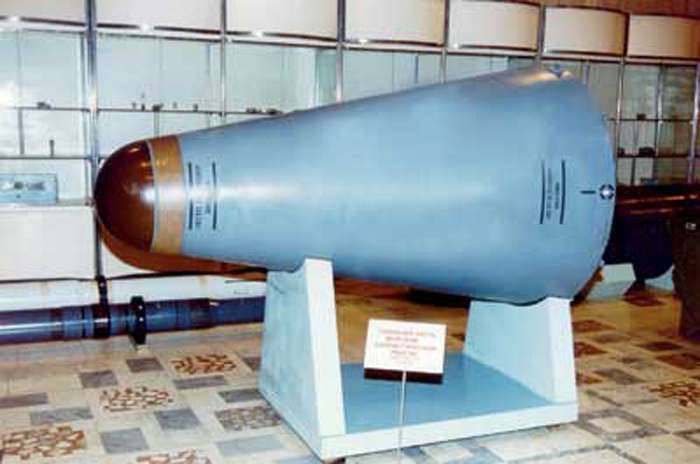
The combat part of the missile P-21. Photo Rbase.new-factoria.ru
For the storage and launch of missiles, a silo-type CM-87 launcher was developed. Its design provided for holding devices protecting the rocket from displacement under various external influences, as well as a launch pad and a set of connectors for connecting the weapon with the onboard carrier systems. In connection with the need to start from under the water, we had to develop a set of connectors placed inside a special pressurized enclosure with pressurized air.
In addition to the launcher, the equipment of the boat carrier should have included systems for filling the mine with water. In order to properly pump water into the annular gap around the rocket, which was not associated with technical risks, it was proposed to first take water into special tanks, after which it could be supplied to the CM-87 unit. This required to balance the submarine intake of water into the surge tank.
According to the results of research and testing, the method of launching the rocket was determined. Product P-21 should have been transported by the carrier in a fully charged state. Before shooting, the submarine had to fill the launch shaft, after which it was possible to open the lid of the latter. At the same time, tanks were pressurized and compressed air was fed into the sealed volume between the bottom of the shaft and the tail section of the rocket. By command of the launch, the rocket had to turn on the main engine and gradually increase its thrust. Reactive gases entering the space above the bottom of the mine, had to create the pressure necessary to remove the rocket from the launcher. In order to avoid damage when moving inside the shaft, the rocket body was equipped with special yoke, which was in contact with the guides of the launcher.
It took about half an hour to carry out the pre-launch preparation of the missile complex. After the launch team, the carrier had the opportunity to shoot off the entire ammunition of three missiles within 10 minutes. During the entire time of preparation and firing, the submarine could remain submerged and did not need to ascend to the surface.
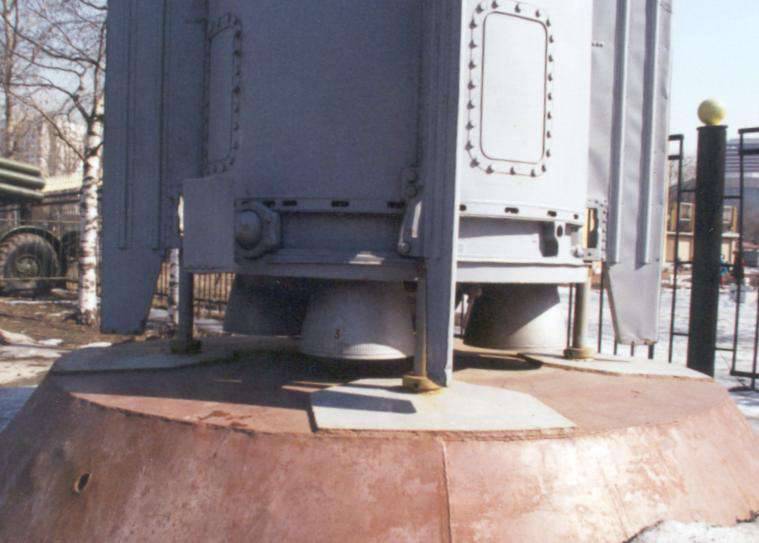
Engine nozzles С5.3 Р-21 rocket. Photo Globalsecurity.org
The P-21 rocket had a length of 12,9 m and a body with a diameter of 1,4 m. The launch weight was 16,6 t. When exiting the mine, the rocket had to move at a speed of about 16,5 m / s, on the water surface the speed reached 30 m / s. The maximum flight speed (when firing at the maximum range) was 3439 m / s. The maximum range was determined at the level of 1420 km. An autonomous inertial control system could provide a CEP (at maximum range) at the level of 2,8 km. Flight duration did not exceed 6,5 min.
By the beginning of 1962, the D-4 / P-21 project was ready for the testing of full-fledged missiles, which were to become the armament of the fleet. The first carrier of the new missiles was to become a diesel-electric submarine K-142 of the 629 project. In accordance with the new project 629B, an experienced submarine lost two existing type of nasal launchers, instead of which CM-87 systems were installed. The third shaft was closed with a plug, since it was planned to be used in the future to conduct new tests of promising complexes.
From 24 in February, the 62 submarine K-142 performed 15 missile launches of the P-21 missiles in motion while moving at speeds up to 3-4 knots. 12 launches are recognized as successful. According to the results of the first tests, joint tests of the submarine of the 629B project, the D-4 complex and the P-21 rocket were launched. At this stage, the checks spent 12 missiles, all launches were successful.
15 May 1963, the USSR Council of Ministers decided to adopt the D-4 complex with the P-21 rocket into service with the Navy. It should be noted that by this time it was already decided to re-equip the future carriers of the P-21 missiles. Back in July, 1962 of the year issued a decree on upgrading the 629 submarines of the updated 629А and 629Б projects with the installation of the D-4 complex systems instead of the existing D-2. Three P-13 missiles were replaced with the same number of P-21. By the beginning of the seventies, new designs of 14 available submarines from the Northern (8 units) and Pacific (6 units) fleets were modernized.
Simultaneously with the submarines of the 629 project, nuclear submarines of the 658 project were upgraded. The updated 658M project implied the dismantling of the existing systems of the D-2 complex for the P-13 missiles with the subsequent installation of the D-4 complex and all the necessary equipment. Before 1967, the D-4 complex with the new rocket received seven of the eight 658 project submarines built. The K-145 boat did not receive the P-21 missiles, but was later rebuilt according to the 701 project and became the carrier of the P-29 products.
The submarines of the 629B and 658M projects were operated for a long time and patrolled in the areas where the strategic targets of the potential enemy were located. Due to the relatively short range of missiles (1420 km), submarines were forced to approach the coast at a small distance, which was associated with the risk of detection by anti-submarine systems.
The P-21 rockets, thanks to their fairly advanced design, could be stored in a filled state without any additional maintenance for six months. Later, taking into account the operating experience, this period was extended to two years, which positively affected the use of weapons by the fleet. After a two-year period, the rocket needed to be removed from the carrier with subsequent maintenance at the base.
In the 1968 year, under unexplained circumstances, one of the carriers of the D-4 / P-21 complex was lost. On March 8, the K-129 submarine of the 629A project, which was patrolling around the Hawaiian Islands, did not contact. On board the submarine there were three missiles P-21. The causes of the accident have not been established. Several versions were considered, from the malfunctioning of the equipment when charging the batteries to the abnormal launch of the rocket engines. Due to the great depth of the ocean in the area of the death of the boat, it is impossible to determine the exact cause of the accident.
In 1977, it was decided to reduce the number of carriers of the P-21 missiles. In connection with the signing of the SALT-1 agreement, the Soviet Union was forced to begin dismantling the D-4 complexes from the submarines of the 658М project. By the end of the decade, the re-equipment of the K-19 submarine was completed, and during the eighties other submarines underwent a similar procedure. In the future, the existing nuclear submarines of this project received new equipment and “mastered” new tactical roles.
The submarines of the 629 family projects did not undergo such modifications and kept the P-21 missiles to the end of their service. The last ships of these types were withdrawn from the fleet in the late eighties and early nineties. After completing the service of the submarines, the D-4 complex with the P-21 / 4K55 missile was removed from service.
The D-4 missile system with the P-21 rocket was put into service in 1963 and operated until 1989. According to reports, from the moment they were commissioned until 1982, when the last shooting took place, the crews of the Navy submarines performed 228 rocket launches. 193 run completed successfully. There were 19 accidents due to malfunctions of the onboard equipment of the rocket, another 11 missiles were lost due to the fault of the crews and the equipment of the carriers. The causes of the five accidents were not identified.
The advent of the D-4 / P-21 rocket complex was an important milestone in stories domestic weapons for the Navy. For the first time in domestic practice, a ballistic missile for submarines capable of launching from under water was created and put into service. This made it possible to significantly increase the shock potential of submarine forces by reducing the probability of detecting and attacking a boat when preparing and launching. In addition, the development of an underwater launch in combination with the further development of rocket technologies allowed domestic specialists to create new ballistic missiles with enhanced characteristics, which have become one of the main elements of strategic nuclear forces.
Based on:
http://rbase.new-factoria.ru/
http://makeyev.ru/
http://russianarms.ru/
http://deepstorm.ru/
http://globalsecurity.org/
http://arms.ru/
Shirokorad A.B. Weapons of the domestic fleet. 1945-2000. - Minsk: “Harvest”, 2001
Apalkov Yu.V. Submarines of the Soviet Navy 1945-1991 Volume I: - M: Morkniga, 2009
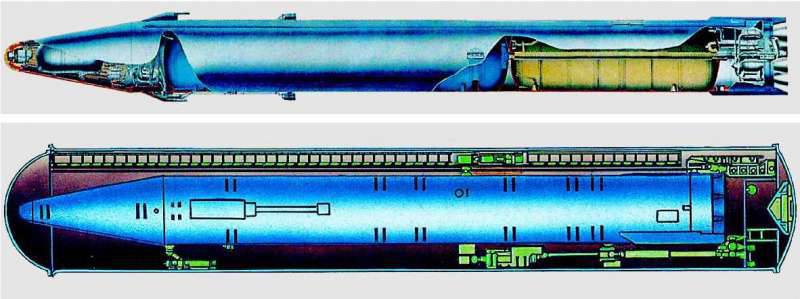


Information